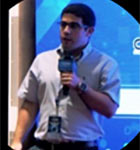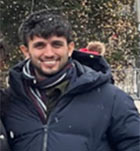Sep
10

Date: 10-11 September 2024
Time: 9:00AM-1:30PM ET (New York Time)
Presenter(s): Dr. Jonatan Ostrometzky, Prof. Hagit Messer,
Mr. Hai Habi, Mr. Dror Jacoby
Credits: 9 PDHs/0.9 CEU
Register Early and Save
Register by 3-September-2024 and save 10% on your registration fee when you use promo code OISAC24 during the checkout process.
Student Discount
Student members register by 3-September-2024 and save 15% on your registration fee when you use promo code STUDENTOISAC24 during the checkout process.
Abstract
The rationale for the short course, including its importance, timeliness, broad usefulness, and how it can possibly introduce new ideas, topics, and tools to the SP community:
The concept of integrated sensing and communication (ISAC) aims at increasing the pareto performance of both functions by designing sensing and communication technologies in an integrated manner. An obvious case where the pareto performance is increased is the case of opportunistic ISAC (OISAC), where the sensing function is added to an existing communication system, or vice versa. In this course we present an overview of the OISAC technology where weather sensing is added to existing wireless communication networks. This opportunistic approach is gaining interest both inside the SP community as well as in nearby fields of research such as earth sciences, as it has been shown to have strong potential to gap the lack in environmental monitoring that is required especially in light of current extreme weather and climate-change local and global effects.
Scope: This course is based on 9 units. Combined, they present the field of opportunistic sensing of weather using wireless communication networks, which is gaining attraction as an OISAC tool, used as a novel layer of environmental monitoring scheme. Specifically, the course starts with an introduction to the field, the motivation behind it, and a detailed presentation of the state of the art. Then, we continue with the presentation of the opportunistic sensor’s physical properties, and demonstration of both model- and data- driven approaches for rain estimation using commercial microwave links. We will also have a discussion of the potential to detect and estimate additional environmental phenomena. During the course, the participants will acquire both the basic theory regarding OISAC tools, and will gain hands-on experience of working with algorithms and real-world dataset for the OISAC application of environmental (e.g. rain) detection and estimation.
Course learning goals:
- Introduction to the OISAC paradigm and its importance for sustainability;
- Understanding the importance of environmental monitoring and challenges therein, and the motivation and solution that OISAC of weather proposes to this field;
- Familiarity with the theoretical grounds that are the basic of all OISAC-based tools, performance analysis and estimation approaches for opportunistic sensing;
- Hands-on experience using actual dataset collected by a real-world operational wireless communication network;
- Exposure to a world-wide community dealing with OISAC of weather, both in the SPS community and in meteorological/hydrological research fields.
Description of target attendees, and the expected prerequisite technical knowledge:
The level of this course is on par with graduate courses in electrical engineering. No further field-specific knowledge is required, as this course is planned to be self-contained with a stand-alone program. Undergraduate-level knowledge of statistical signal processing and basic physics and engineering aspects is assumed, and basic knowledge of working with GitHub, and running python code is preferrable (but not required).
The course is built for graduate students, researchers, as well as signal processing engineers interested in getting an orderly introduction and first hands-on experience of OISAC of weather concepts.
Description of hands-on or lab components of the short course:
This course includes a guided hands-on exercise (unit 7 of the course) that will introduce to the participants the publicly available datasets as well as existing open-source software. During the hands-on, we will download actual datasets of attenuation time series collected by actual commercial microwave links from a wireless communication network. Using these datasets, we will examine and present the use of algorithms to produce rain detection and estimation products. At the end of this hands-on, the participants should have access to several publicly available datasets, to the code of state-of-the-art selected model- and data- driven algorithms, and first-hand experience of using these resources and algorithms.
Instructors

Dr. Jonatan Ostrometzky
Website: https://ostrometzky.eng.tau.ac.il/
Email: jonatano@tauex.tau.ac.il

Prof. Hagit Messer
Website: https://www.messer.sites.tau.ac.il/
Email: messer@eng.tau.ac.il

Mr. Hai Habi
Ph.D. student at the CelleNMon Lab
Email: haivictorh@mail.tau.ac.il

Mr. Dror Jacoby
Ph.D. candidate at the CelleNMon Lab
Email: drorjacoby@mail.tau.ac.il
